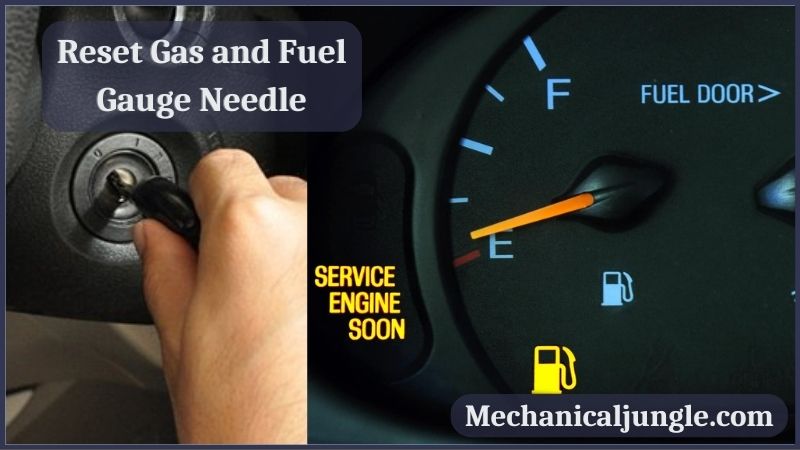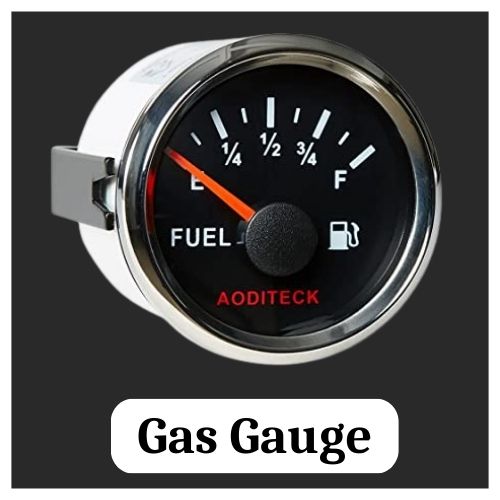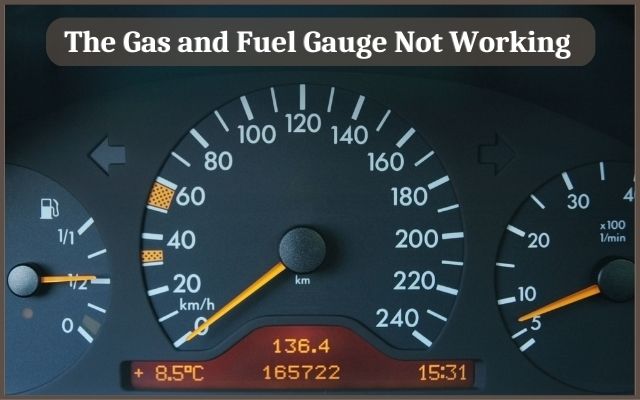
Gas Gauge

You’ll know how aggravating it may be if you’ve ever driven until you ran out of gas and then had to reset the needle on your gas gauge. When you put extra gas in the tank, the gas gauge should start working immediately; nevertheless, there are occasions when it does not move and needs to reset.
Find the wire connecting your gas gauge to its transmitting unit, and remove it from the connector. For grounding, attach this wire to a component of your car that is made of metal.
You should see the pointer on your gas gauge return to the “Empty” position, at which point you can reconnect the batteries. In this post, we will guide you through resetting the needle on your gas gauge step by step so that you can get back on the road.
This is a procedure that can be completed in a matter of minutes, and it has the potential to save you from having a gas emergency in the future.
How to Reset Gas Gauge Needle
If the fuel gauge in your vehicle gives you an erroneous measurement or display of the fuel currently in the gas tank, the problem is most likely caused by a problem with the software or the electronic components that make up the fuel gauge.
Resetting the fuel gauge is the primary remedy to the problem of an incorrect fuel gauge. The technique that must be followed to reset the fuel gauge on a car is often outlined in the handbook or manual that comes with the automobile.
Nonetheless, the steps are the same for the majority of vehicle types.
- To start the engine, move the ignition switch to the “ON” position.
- The “ODO” mode of the Odometer can be accessed by pressing the “Trip/Odo” button.
- Stop the engine and turn off the ignition.
- While holding it down, press the “Trip/Odo” button. After turning on the ignition switch, hold down the “Trip/Odo” switch for approximately two seconds. The “Trip/Odo” button needs to be depressed, then released, pressed again (this process should be repeated three or four times), and finally held down for approximately four to five seconds so that the leveling information displays on the Odometer. Then you should let go of the button labeled “Trip/Odo.”
- Once more, push and hold the “Trip/Odo” button until the “1” appears on the Odometer display. This signifies the beginning of the process of resetting the device.
- Last but not least, once the odometer display has returned to its stable state, you can remove your finger from the “Trip/Odo” button because the reset process is over.
How to Reset Fuel Gauge Needle Mercedes
- Stop the car and turn it off.
- Take off the fuse box cover inside and below the passenger side door.
- Remove the blue fuse numbered F5 with 15A capacity.
- Check it out, then put it back in the slot.
- After the fuel gauge was reset, the car’s ignition needed to be turned on to begin functioning properly again.
When to Reset the Gas Gauge Needle
When the needle on the gas gauge starts moving in an unpredictable pattern, you should reset the gauge. One of the earliest and most blatant indications that there is a problem is when this occurs (likely with the fuel gauge sender).
For instance, the needle might suggest that you have a half-full tank at one point, and then just a few minutes later, it might abruptly plummet to a quarter-full reading.
Reset the gauge whenever the needle becomes fixed on the “Empty” position, regardless of the current level of gasoline. This is a common indication that the fuel gauge needs to reset.
This is intentional because it is safer to believe that your tank is empty and add more gas as a precaution rather than the other way around. Turning the car off and then back on may provide a temporary solution to this problem.
You will need to reset the needle if it does not budge from the “Full” position. This is a less common indication of a problem with the gauge or the sender.
If this happens, you need to ensure that you fill up your tank as regularly as possible because, once the gauge is fixed, you will be able to see how much fuel you have.
The gasoline-sending unit is the most likely culprit when the fuel gauge gives an inaccurate reading, as this is the most prevalent source of the problem.
The fuel-sending unit is responsible for determining how much fuel is currently stored in the fuel tank and relaying that information to the fuel gauge on the vehicle’s dashboard. The fuel gauge is the first indicator of anything wrong with the fuel-sending unit if the problem occurs.
How a Fuel-Sending Unit Measures Fuel Tank Levels
The float inside the gasoline tank will rise or fall in response to the height of the fuel in the tank. Because of the movement of the metal rod concerning the float, the wiper included within the variable resistor is also allowed to move.
Each manufacturer designs its fuel-sending units to operate uniquely. whereas the fuel-sending unit on a GM vehicle of the same year will be the one closest to the ground when the tank is full. Consult the service handbook to understand how your vehicle’s gasoline-sending unit reads the resistance.
On the resistive material strip, the windshield wiper will either be the closest to the ground or the farthest from the ground when the fuel tank is filled.
This is either the point where there is the least amount of resistance or the maximum amount of resistance. When a vehicle is running on its last few drops of fuel, the wiper again is either closest to or furthest from the ground because the float rests at the bottom of the metal rods travel.
The fuel gauge will display either full or empty, depending on the resistance. It reads as full or empty, which will vary depending on the specs of the gauge.
When the fuel level and the float drop in the tank, the metal rod connected to the float moves the wiper further away from the ground or closer to it, this either decreases or increases the electric current sent to the fuel gauge.
The change in resistance causes the fuel gauge display to move away from the full position.
What Causes a Fuel Gauge Not to Work?

The fuel gauge indicates no fuel when the tank is full. The float may have come loose from the arm in the fuel-sending unit, which has caused the rest of the components in the unit to come to a complete stop.
This would cause the fuel gauge only to read “empty.” A defective resistor can sometimes cause the gauge to read empty by limiting the signal to the point where it is no longer detectable.
Wires that have corroded, particularly those that are part of a fuel-sending unit mounted on the gasoline pump, have the potential to interrupt the flow of voltage from the source or to the fuel gauge.
- The fuel gauge is frozen on the full mark. It’s possible that a malfunctioning fuel gauge resistor is to blame for a fuel gauge that only ever displays full because it constantly supplies the fuel gauge with the full voltage. When a vehicle routinely utilizes fuel, the fuel-sending unit is in motion all the time, which causes the wiper in the variable resistor to move all the time. This can eventually cause the resistive material strip to become worn out, resulting in an open circuit.
- The fuel gauge moves back and forth between being empty and full.
It’s possible that the mechanical problem is to blame for a fuel gauge display that vacillates between showing empty and full. The float arm of the gasoline-sending unit can become “stuck” at certain levels and then either fall back into place on its own or with the assistance of vehicle movement.
The accuracy of the fuel gauge will be restored after the float arm is returned to its proper position. This occurrence can frequently be reproduced, providing additional evidence of a mechanical failure. In some instances, this problem could also be caused by a malfunctioning fuel gauge.
What Are Bad Gas Gauge Needle Symptoms?
Many different things could go wrong with the needle on the gas gauge, including the following:
- A problem with the float: The float is susceptible to becoming broken or stuck, which prevents it from rising and falling in response to changes in the fuel level. An issue with the wire: If it becomes frayed or broken, it will no longer be able to send a signal to the gauge.
- An issue with the gauge: The gauge has the potential to become damaged or malfunction, which would prohibit it from reading the signal from the wire in an accurate manner.
- A connection that is not secure: If the connection is not secure, the signal may not reach the gauge, resulting in the needle moving erratically.
How Are Gas Gauge Needle Problems Diagnosed?
They will look over the float, looking for any signs of damage or debris that might be stopping it from flowing smoothly and inspecting any areas they find.
- The wire will be inspected, and the person doing so will look for fraying, breakage, and other damage types.
- Examine the gauge: They will look for any indications of damage or dysfunction in the instrument.
- They will check the connections and ensure that they are secure and that there are no loose ends.
How to Inspect Float
You can take the float out of the tank and look for damage to it if you have reason to believe that it may be the source of the issue. To accomplish this, you will need to:
- Take off the cap of the gas tank.
- Turn the float bowl screw counterclockwise to remove it, and then pull the bowl out.
- To remove the float assembly, carefully pull it out.
- Examine the float for any signs of damage or debris that might prevent it from moving freely and unrestrictedly. If it is dirty, wipe it down with a mild cleaner and wait until it has dried completely before reinstalling it.
- Replace the screw, gas cap, and float assembly.
How to Replace the Gauge
- Remove the cable that connects the negative terminal of the battery.
- Take out any screws or bolts securing the gauge in its current position.
- Take care to remove the gauge, and then detach the wires attached to the back.
- Put a replacement gauge in place and make sure the wires are properly connected to it.
- Replace the screws or bolts that were previously used to secure the gauge in place.
- Reconnect the cable that goes to the battery’s negative terminal.
There might be an issue with the float, the cable, or the gauge itself; alternatively, the problem might be a loose connection. A competent mechanic can fix your gas gauge, who will first identify the issue and then put it back in working order.
How Often Should I Check My Gas Gauge?
It is in your best interest to perform routine maintenance on your gas gauge to ensure that it is accurate and reliable. If you notice any bad gas gauge needle symptoms, such as a needle that doesn’t move, an erratic needle, or a needle that’s stuck, you should also check it out.
A malfunctioning gas gauge is an annoyance and a potential safety hazard because driving without sufficient fuel can cause expensive damage to a vehicle.
If yours is malfunctioning, the gas gauge needle can be reset by following these steps. You can quickly get your gas gauge back to working properly with a little investigation and troubleshooting.
How Are the Gas Gauge Needle Problems Repaired?
When there are issues with the needle on the gas gauge, the necessary repairs will vary depending on the root cause of the issue. Possible fixes include the following:
- Changing the float It is necessary to change the float if it is broken or stuck in its position.
- Wires that have become frayed or broken will require replacement. If the wire has become frayed or broken, it will need to be replaced.
- The gauge will need to be replaced if it has been damaged or is no longer functioning properly.
- The connections will need to be tightened if they are loose; if they are, the connections will need to be tightened.
The symptoms of a faulty gas gauge needle can range from a needle that doesn’t move at all to a needle that moves erratically or gets stuck.
There might be an issue with the float, the wire, or the gauge itself; alternatively, the problem might be a loose connection. A qualified mechanic can fix your gas gauge, who will diagnose the issue, and then put it back in working order.
To begin, you must disengage the negative battery terminal by releasing the nut that holds the cable to the terminal in place. Next, find the sending unit for the gas gauge, and remove the wire from the gas gauge that connects it to the sending unit.
Connecting this wire to a metal component of your vehicle will serve as a ground. You should see the needle on your gas gauge move back to the “empty” position. Last but not least, reattach the negative terminal of the battery. Your gas gauge needs to be reset, and you should ensure
It Is Functioning Correctly
Repairs could be as straightforward as swapping out a wire or float or as involved as replacing the entirety of the gas gauge, depending on the nature of the issue that necessitated them.
In either case, resolving the issue as soon as possible is essential to maintain an accurate reading of the fuel level in your vehicle. Maintaining your vehicle on a routine basis and addressing any issues that may arise will keep it operating efficiently and help you avoid unneeded breakdowns.
FAQs: Gas Gauge Reset and Troubleshooting
Why Would I Need to Reset My Gas Gauge?
Gas gauges can sometimes display incorrect readings due to issues with the sending unit or electrical components. Resetting helps recalibrate the gauge to display accurate fuel levels.
How Often Should I Reset My Gas Gauge?
Resetting your gas gauge is typically done when you notice erratic readings or after performing maintenance on fuel-related components. It’s not a routine task but rather a troubleshooting step.
What Are the Signs That My Gas Gauge Needs Resetting?
Signs include the needle stuck at “Full” or “Empty,” erratic movements of the needle, or consistent incorrect fuel level readings despite refueling.
Can Resetting My Gas Gauge Fix All Issues with Fuel Level Readings?
Resetting is primarily used to recalibrate the gauge. If there are underlying issues such as a faulty sending unit or damaged wiring, further diagnostics and repairs may be needed.
How Do I Know If My Gas Gauge Issue Is Due to the Sending Unit?
Issues with the sending unit can cause the gauge to display incorrect readings. If resetting the gauge doesn’t resolve the problem, consulting a mechanic for a diagnostic check of the sending unit is recommended.
What Should I Do If My Gas Gauge Still Doesn’t Work After Resetting?
If resetting doesn’t resolve the issue, it could indicate a deeper problem with the gauge, wiring, or sending unit. Consulting a professional mechanic for further inspection and repair is advisable.
Is Resetting the Gas Gauge Something I Can Do Myself?
Yes, resetting the gas gauge can often be done following simple steps outlined in your vehicle’s manual or similar guides. However, if you’re unsure or uncomfortable with DIY repairs, it’s best to seek assistance from a qualified technician.
Can a Malfunctioning Gas Gauge Impact Vehicle Performance?
While the gauge itself doesn’t affect performance, inaccurate fuel level readings can lead to running out of fuel unexpectedly, potentially causing inconvenience and damage to the vehicle.
Are There Preventive Measures to Avoid Gas Gauge Issues?
Regular maintenance of your vehicle’s fuel system, including checking the sending unit and electrical connections, can help prevent gas gauge issues. Additionally, keeping track of fuel levels manually can provide an early warning if the gauge begins to malfunction.
What Should I Do If I Suspect a Problem with My Gas Gauge?
If you notice any abnormal behavior with your gas gauge, such as sudden drops or inaccurate readings, it’s advisable to address the issue promptly. Ignoring potential problems can lead to more significant issues down the road.

